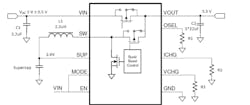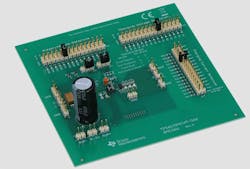Ultra-Low-Iq Buck/Boost Converter Charges, Manages Supercaps
This article is in TechXchange: Why Low Iq is the Smart Thing to Do
Not so long ago, one of the major design considerations for power-supply subsystems in industrial data acquisition was their ability to operate using the relatively high compliance of the 4- to 20-mA current-loop voltage (e.g., 24 V dc) and the “unused” 4 mA in that loop. Other data-acquisition applications such as medical monitoring—almost always wired—had somewhat similar low-power concerns, as well.
Now, priorities have dramatically changed, with an emphasis on low-power operation for wired and especially wireless IoT and medical devices, including compatibility with long-life batteries, supercapacitors, energy harvesting, or some combination of these sources. Along with the requirement for ultra-low-power operation is a need for extremely low quiescent current (IQ) to minimize energy drain in the lull between the IoT-device reporting cycles with their fairly low duty cycles.
Targeting these requirements, the TPS61094 developed by Texas Instruments is a bidirectional buck/boost dc-dc converter with an IQ of just 60 nA—claimed to be one-third the value of competing boost converters. It integrates a buck mode for supercapacitor charging along with that ultra-low IQ, thus extending battery life by as much as 20% when compared to use of hybrid-layer capacitors (HLCs). (a HLC is a construct that’s somewhat of an intermediary between a battery and a full supercapacitor).
The dc-dc converter addresses the need to achieve high efficiency at no- or light-load conditions (in the low milliampere or microampere range), which, in turn, requires power supplies to regulate their output while maintaining ultra-low supply current in the nanoampere range.
The TPS61094 combines two key benefits here that often demand tradeoffs: the design simplicity of using an integrated buck/boost converter and the extended battery life enabled by high output current and low IQ. In a typical application providing supercapacitor-based backup, the TPS61094 can charge the supercapacitor or boost it to power the output (Fig. 1).
Key specifications include wide voltage and current ranges:
- 0.7- to 5.5-V input-voltage range
- 1.8-V minimum input voltage for startup
- Programmable boost output voltages (2.7- to 5.4-V setting range)
- Programmable buck-charging termination voltages (1.7- to 5.4-V setting range)
- Programmable buck charging output currents (2.5- to 600-mA setting range)
Among its features are:
- Two 60-mΩ (low-side)/140-mΩ (high side) MOSFETs
- 100-mΩ bypass-switch resistance
- 1-MHz switching frequency
- Auto-snooze mode operation at light load
- Up to 92.3% efficiency at VIN = 3 V, VOUT = 3.6 V, and IOUT = 10 µA; up to 96.3% efficiency at VIN = 3 V, VOUT = 3.6 V, and IOUT = 100 mA
The 2-A inductor-current limit in boost operation is twice that of competitive units and is suitable for supporting a range of radio standards over a wider input voltage range (for example, the more than 250 mA of output current down to an input voltage of 0.7 V).
The TPS61094’s combination of 60-nA IQ and supercapacitor charging/discharging capability enables engineers to replace HLCs with supercapacitors for peak-load support and extend battery life by as much as 20% in applications that must run on a single battery for 10 years or more, according to TI. Alternatively, it can provide backup power in applications requiring safe power-down or “last-gasp” communication during a power outage.
The comprehensive 42-page datasheet includes test specifications, performance graphs, a state transition diagram, application examples and layout considerations, and design equations such as those needed for selecting inductor and capacitor values. (Note that sizing the inductor involves finding a “sweet spot” among inductor value, saturation current, and dc resistance.)
In addition to the datasheet and Spice models, TI has considerable support and application collateral including two blogs, “3 benefits of using a low-IQ buck/boost converter to extend battery life in flow meters ” and “Effective ways to implement backup power from supercapacitors,” as well as a 14-page application note, “A long-lifetime, cost-competitive solution in smart meters based on the TPS61094.” For hands-on experience, there’s the TPS61094EVM-066 evaluation board with a 16-page hardware-focused User’s Guide (Fig. 2).
The TPS61094, housed in a 2- × 3-mm, 12-pin, very thin, small-outline, no-lead (WSON) package, is priced at $1.20 in 1,000-unit quantities, while the corresponding evaluation module is $99.
Read more articles in TechXchange: Why Low Iq is the Smart Thing to Do


